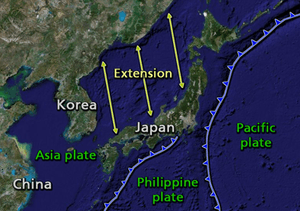Geology of Japan


Formation of Japanese Islands
The islands of Japan are primarily the result of several large ocean movements occurring over hundreds of millions of years from the mid-Silurian to the Pleistocene as a result of the subduction of the Philippine Sea Plate beneath the continental Amurian Plate and Okinawa Plate to the south, and subduction of the Pacific Plate under the Okhotsk Plate to the north.
Around 23 million years ago, the now Western Japan was a coastal region of the Eurasia continent. The subducting plates, being deeper than the Eurasian plate, pulled parts of Japan which become modern Chūgoku region and Kyushu eastward, opening the Sea of Japan (simultaneously with the Sea of Okhotsk) around 15-20 million years ago, with likely freshwater lake state before the sea has rushed in.[1] Around 16 million years ago, in Miocene period, a peninsula attached to the eastern coast of the Eurasian continent was well formed. About 11 million years before present, the parts of Japan which become modern Tohoku and Hokkaido were gradually uplifted from the seafloor, and terranes of Chūbu region were gradually accreted from the colliding island chains. The Strait of Tartary and the Korea Strait opened much later, about 2 million years ago. At the same time, a severe subduction of Fossa Magna graben have formed the Kantō Plain.[2]
Geological composition
General information
Overall, the geological composition of Japan is poorly understood. Japanese islands are formed of several geological units parallel to the subduction front. The parts of islands facing oceanic plates are typically younger and display larger proportion of volcanic products, while the parts facing Sea of Japan are mostly heavily faulted and folded sedimentary deposits. In north-west Japan, the thick quaternary deposits make determination of the geological history especially difficult.[3]
Geological structure
The Japanese islands are divided into three major geological domains:
- Northeastern Japan, north of Tanakura fault (which had high volcanic activity 14-17 million years before present[4])
- Central Japan, between Tanakura fault and Itoigawa-Shizuoka Tectonic Line.
- Southwestern Japan, south of Itoigawa-Shizuoka Tectonic Line. The Southwestern Japan is further subdivided into several metamorphic belts stretched along Japan Median Tectonic Line.[5]
- Urasoko fault
- Fukozu Fault
- Neodani Fault
- Nojima Fault
- Hida orogenic belt
- Sangun orogenic belt
- Maizuru orogenic belt
- Tanba-mino orogenic belt
- Ryoke orogenic belt
- Shimanto orogenic belt[6]
- Sambagawa orogenic belt[7]
- Chichibu orogenic belt[8]
- Sambosan orogenic belt
- Beppu–Shimabara graben
Research on Geology of Japan
The Geology of Japan is handled mostly by Geological Society of Japan (日本地質学会), with following major periodicals:
- Geological Journal (地質学雑誌) - since 1893
- Geological Studies (地質学論集) - since 1968
- Geological Society of Japan News (日本地質学会News) - since 1998
Current geological hazards of Japanese Islands
Japan is situated in a volcanic zone on the Pacific Ring of Fire. Frequent low intensity earth tremors and occasional volcanic activity are felt throughout the islands. Destructive earthquakes, often resulting in tsunamis, occur several times a century. The most recent major quakes include the 2011 Tōhoku earthquake and tsunami, the 2004 Chūetsu earthquake and the Great Hanshin earthquake of 1995. Hot springs are numerous and have been developed as resorts.
See also
References
- ↑ Barnes, Gina L. (2003). "Origins of the Japanese Islands: The New "Big Picture"" (PDF). University of Durham. Retrieved August 11, 2009.
- ↑ "Formation history of the Japanese Islands (4) -- GLGArcs". glgarcs.rgr.jp. Retrieved July 16, 2017.
- ↑ "Geology of Japan|Geological Survey of Japan, AIST|産総研地質調査総合センター / Geological Survey of Japan, AIST". gsj.jp. Retrieved July 16, 2017.
- ↑ "Yurie SAWAHATA, Makoto Okada, Jun Hosoi, Kazuo Amano, "Paleomagnetic study of Neogene sediments in strike-slip basins along the Tanakura Fault". confit.atlas.jp. Retrieved July 16, 2017.
- ↑ connelly@geo.arizona.edu. "Southwest Japan". geo.arizona.edu. Retrieved July 16, 2017.
- ↑ A. Taira, H. Okada, J. H. McD. Whitaker & A. J. Smith, The Shimanto Belt of Japan: Cretaceous-lower Miocene active-margin sedimentation
- ↑ "Sanbagawa belt (Sambagawa metamorphic belt), Shikoku Island, Japan". mindat.org. Retrieved July 16, 2017.
- ↑ "Chichibu belt from geo.arizona.edu". geo.arizona.edu. Retrieved July 16, 2017.
Further reading
- Hashimoto, M., ed. (1990). Geology of Japan. Dordrecht: Kluwer Academic Publishers. ISBN 9780792309093.
- T. Moreno (Editor), S.R. Wallis (Editor), T. Kojima (Editor), W. Gibbons (Editor) (ed.). Geology of Japan (Geological Society of London)(2015). ISBN 978-1862397439.
by - (Author),
- Takai, Fuyuji; Tatsurō Matsumoto; Ryūzō Toriyama (1963). Geology of Japan. University of California Press.
External links
|
|
- National Archives of Japan: Tatoroyama no ki, survey of limestone cave in Mount Tatoro in Kozuke Province, 1837 (Tenpo 8).